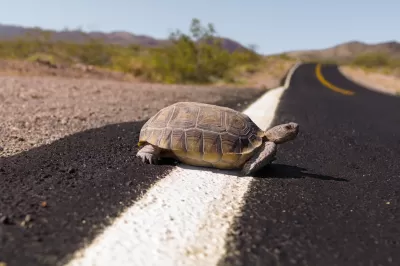A new state law requires new development and infrastructure to minimize disruption to local wildlife habitats and migration patterns.

California’s Room to Roam Act (AB 1889), signed by Governor Gavin Newsom last week, requires local governments to “minimize the disruption of wildlife movement” and calls for wildlife-friendly fencing and lighting in new development.
According to a press release from the Center for Biological Diversity, the new bill recognizes the impacts of human development on wildlife habitat and migration. “Light pollution can confuse migrating birds and make them crash into buildings, while poorly designed fences can unintentionally trap deer and other wildlife. Many animals like mountain lions and desert tortoises are struggling because ill-conceived development has sliced up their habitat, leaving them unable to find food and shelter. Some suffer from harmful inbreeding due to habitat fragmentation.”
The new law complements the Safe Roads and Wildlife Protection Act (AB 2344), which prioritizes wildlife crossings on state highways. The world’s largest wildlife crossing, which will span the 101 freeway near the Santa Monica Mountains, broke ground in Los Angeles in April of this year.
FULL STORY: Governor Signs Bill to Improve California’s Wildlife Connectivity

Trump Administration Could Effectively End Housing Voucher Program
Federal officials are eyeing major cuts to the Section 8 program that helps millions of low-income households pay rent.

Planetizen Federal Action Tracker
A weekly monitor of how Trump’s orders and actions are impacting planners and planning in America.

Ken Jennings Launches Transit Web Series
The Jeopardy champ wants you to ride public transit.

California Invests Additional $5M in Electric School Buses
The state wants to electrify all of its school bus fleets by 2035.

Austin Launches $2M Homelessness Prevention Fund
A new grant program from the city’s Homeless Strategy Office will fund rental assistance and supportive services.

Alabama School Forestry Initiative Brings Trees to Schoolyards
Trees can improve physical and mental health for students and commnity members.
Urban Design for Planners 1: Software Tools
This six-course series explores essential urban design concepts using open source software and equips planners with the tools they need to participate fully in the urban design process.
Planning for Universal Design
Learn the tools for implementing Universal Design in planning regulations.
Ada County Highway District
Clanton & Associates, Inc.
Jessamine County Fiscal Court
Institute for Housing and Urban Development Studies (IHS)
City of Grandview
Harvard GSD Executive Education
Toledo-Lucas County Plan Commissions
Salt Lake City
NYU Wagner Graduate School of Public Service





























